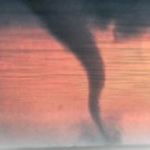Information
-
Document No.
-
Audit Title
-
Client / Site
-
Conducted on
-
Prepared by
-
Location
-
Personnel
-
Tornado General Description
-
A tornado is a violently rotating column of air extending from the base of a thunderstorm down to the ground. Tornado intensities are classified on the Fujita Scale with ratings between F0 (weakest) to F5 (strongest). They are capable of completely destroying wellmade structures, uprooting trees and hurling objects through the air like deadly missiles. Although severe tornadoes are more common in the Plains States, tornadoes have been reported in every state.
-
Know the difference
-
Tornado Watch: Tornadoes are possible in and near the watch area. Review and discuss your emergency plans, and check supplies and your safe room. Be ready to act quickly if a warning is issued or you suspect a tornado is approaching. Acting early helps to save lives!
-
Tornado Warning: A tornado has been sighted or indicated by weather radar. Tornado warnings indicate imminent danger to life and property. Go immediately underground to a basement, storm cellar or an interior room (closet, hallway or bathroom).
What should I do to prepare for a tornado?
-
During any storm, listen to local news or a NOAA Weather Radio to stay informed about watches and warnings.
-
Know your communitys warning system. Communities have different ways of warning residents about tornados, with many having sirens intended for outdoor warning purposes.
-
Pick a safe room in your home where household members and pets may gather during a tornado. This should be a basement, storm cellar or an interior room on the lowest floor with no windows.
-
Practice periodic tornado drills so that everyone knows what to do if a tornado is approaching.
-
Consider having your safe room reinforced. Plans for reinforcing an interior room to provide better protection can be found on the FEMA Web site at http://www.fema.gov/ plan/prevent/rms/rmsp453.shtm
-
Prepare for high winds by removing diseased and damaged limbs from trees.
-
Move or secure lawn furniture, trash cans, hanging plants or anything else that can be picked up by the wind and become a projectile.
-
Plan how to take care of your pets. If you must evacuate, it is best to take your pets with you. However, pets (other than service animals) are not permitted in public shelters, according to many local health department regulations and because of other considerations.
First Aid Kit
-
Assemble a first aid kit for your Disaster Supplies Kit and one for each car.
-
The basics for your first aid kit include:
-
First aid manual.
-
Sterile adhesive bandages in assorted sizes.
-
Assorted sizes of safety pins.
-
Cleansing agent/soap.
-
Latex gloves (2 pairs).
-
Sunscreen.
-
2-inch sterile gauze pads (4-6).
-
4-inch sterile gauze pads (4-6).
-
Triangular bandages (3).
-
Nonprescription drugs.
-
2-inch sterile roller bandages (3 rolls).
-
3-inch sterile roller bandages (3 rolls).
-
Scissors.
-
Tweezers.
-
Needle.
-
Moistened towelettes.
-
Antiseptic.
-
Thermometer.
-
Tongue depressor blades (2).
-
Tube of petroleum jelly or other lubricant.
-
Have the following nonprescription drugs in your Disaster Supplies Kit:
-
Aspirin or nonaspirin pain reliever.
-
Antidiarrhea medication.
-
Antacid (for stomach upset).
-
Syrup of ipecac (use to induce vomiting if advised by the poison control center).
-
Laxative.
-
Activated charcoal (use if advised by the poison control center).
-
Vitamins.
-
Add any necessary prescription and nonprescription drugs.
-
Add special needs for infants, elderly persons, or anyone with serious allergies.
Important Documents
-
Keep the following original documents in a safe deposit box if possible, and copies in a waterproof, fire-resistant portable container:
-
Will, insurance policies, contracts, deeds, stocks and bonds.
-
Passports, social security cards, immunization records.
-
Bank account numbers.
-
Credit card account numbers and companies.
-
Inventory of valuable household goods with photograph if possible.
-
Important Telephone Numbers
-
Family records (birth, marriage, death certificates).
Home Disaster Supplies Kit
-
In addition to your Disaster Supplies Kit basics and Evacuation Supplies Kit, gathering the following items will help your family endure home confinement, which often happens following disasters and may include the loss of utilities.
-
Wrench to turn off household gas and water. Keep it near the shut-off valves.
-
A weeks supply of food and water.
-
Additional blankets and sleeping bags.
-
Also, consider using a NOAA Weather Radio with the tone-alert feature in your home. NOAA Weather Radio is the best means for receiving warnings from the National Weather Service. The National Weather Service continuously broadcasts updated weather warnings and forecasts that can be received by NOAA Weather Radios sold in many stores. NOAA Weather Radio now broadcasts warning and postevent information for all types of hazards--both natural (such as earthquakes and volcanic activity) and technological (such as chemical releases or oil spills). Working with other federal agencies and the Federal Communications Commissions new Emergency Alert System, NOAA Weather Radio is an "all hazards" radio network, making it the single source for the most comprehensive weather and emergency information available to the public.
Water
-
Having an ample supply of clean water is a top priority in an emergency.
-
Store water in plastic containers, such as soft drink plastic bottles. Seal containers tightly, label them and store in a cool, dark place. Replace water every six months. Avoid using containers that will decompose or break, such as milk cartons or glass bottles.
-
Keep at least a three-day supply of water, or a minimum of three gallons per person. It is strongly recommended to have more if possible. Use one-half gallon per day for drinking, and one-half gallon for cooking and sanitation. A normally active person needs to drink at least two quarts of water each day. Hot environments and intense physical activity can double that amount. Children, nursing mothers, and ill people will need more. Store your three-day supply in a handy place. You need to have water packed and ready in case there is no time to fill water bottles when disaster strikes.
-
Water needs to be treated only if it is of questionable purity.
-
Boiling is the safest method of treating water. Strain water through a clean cloth to remove bulk impurities. Bring water to a rolling boil for about one full minute, keeping in mind that some water will evaporate. Let the water cool before drinking. Boiled water will taste better if you put oxygen back into it by pouring the water back and forth between two clean containers. This will also improve the taste of stored water.
-
You can use household liquid bleach to kill microorganisms. Use only regular household liquid bleach that contains 5.25 percent sodium hypochlorite. Do not use scented bleaches, color-safe bleaches, or bleaches with added cleaners. Add 16 drops of bleach per gallon of water, stir, and let stand for 30 minutes. If the water does not have a slight bleach odor, repeat the dosage and let stand another 15 minutes. If it still does not smell of chlorine, discard it and find another source of water. Other chemicals, such as iodine or water treatment products sold in camping or surplus stores that do not contain 5.25 percent hypochlorite as the only active ingredient, are not recommended and should not be used.
-
Distillation involves boiling water and then collecting the vapor that condenses back to water. The condensed vapor will not include salt or other solid impurities. To distill, fill a pot halfway with water. Tie a cup to the handle on the pots lid so that the cup will hang rightside up when the lid is upside down (make sure the cup is not touching the water) and boil the water for 20 minutes. The water that drips from the lid into the cup is distilled.
-
Melt ice cubes or use water from undamaged hot water tanks, toilet tanks (not the bowl), and water pipes if you need additional water.
-
If you need to find water outside of your home, you can use rainwater; streams, rivers, and other moving bodies of water; ponds and lakes; and natural springs. If you question its purity, be sure to treat the water first. Avoid water with floating material, an odor, or a dark color. Use saltwater only if you distill it first. Do NOT drink flood water.
Food
-
Even though it is unlikely that an emergency would cut off your food supply for two weeks, you should consider preparing a supply that will last that long. The easiest way to develop a two-week stockpile is to increase the amount of basic foods you normally keep on your shelves. If your water supply is limited, try to avoid foods that are high in fat and protein, and dont stock salty foods, since they will make you thirsty. Familiar foods can lift morale and give a feeling of security in time of stress. Also, canned foods wont require cooking, water, or special preparation. Take into account your familys unique needs and tastes. Try to include foods that they will enjoy and that are also high in calories, protein, carbohydrates, vitamins, and minerals.
-
Pack at least a three-day supply of nonperishable food and water, and store it in a handy place. You need to have these items packed and ready in case there is no time to gather food from the kitchen when disaster strikes.
-
Select foods that require no refrigeration, preparation, or cooking, and little or no water. Foods that are compact and lightweight are easy to store and carry.
-
If you must heat food, pack a can of cooking fuel.
-
Try to eat salt-free crackers, whole grain cereals, and canned food with high liquid content.
-
Recommended foods include:
-
Ready-to-eat canned meats, fruits, and vegetables.
-
Canned juice, milk, and soup (if powdered, store extra water).
-
High-energy foods, such as peanut butter, jelly, crackers, granola bars, and trail mix.
-
Comfort foods, such as hard candy, sweetened cereals, candy bars, and cookies.
-
Instant coffee, tea bags.
-
Foods for infants, elderly persons, or persons on special diets, if necessary.
-
Also consider:
-
Compressed food bars. They store well, are lightweight, taste good, and are nutritious.
-
Trail mix. Available prepackaged, or assemble your own.
-
Dried foods. They can be nutritious and satisfying, but contain a lot of salt, which promotes thirst.
-
Freeze-dried foods. They are tasty and lightweight, but will need water for reconstitution.
-
Instant meals. Cups of noodles or cups of soup are a good addition, although they need water for reconstitution.
-
Snack-sized canned goods. Good because they generally have pull-top lids or twist-open keys.
-
Prepackaged beverages. Those in foil packets and foil-lined boxes are suitable because they are tightly sealed and will keep for a long time.
-
Food options to avoid:
-
Commercially dehydrated foods. They can require a great deal of water for reconstitution and extra effort in preparation.
-
Bottled foods. They are generally too heavy and bulky, and break easily.
-
Meal-sized canned foods. They are usually bulky and heavy.
-
Whole grains, beans, pasta. Preparation could be complicated under the circumstances of a disaster.
If your electricity goes off:
-
First, use perishable food and foods from the refrigerator.
-
Then, use the foods from the freezer. To minimize the number of times you open the freezer door, post a list of freezer contents on it. In a well-filled, well-insulated freezer, foods will usually still have ice crystals in their centers (meaning foods are safe to eat) for at least three days.
-
Finally, begin to use nonperishable foods and staples.
-
Remember to store nonperishable foods for your pets.
Watch for tornado danger signs:
-
Dark, often greenish clouds a phenomenon caused by hail
-
Wall cloud an isolated lowering of the base of a thunderstorm
-
Cloud of debris
-
Large hail
-
Funnel cloud - a visible rotating extension of the cloud base
-
Roaring noise
What should I do if a tornado is threatening?
-
The safest place to be is an underground shelter, basement or safe room.
-
If no underground shelter or safe room is available, a small, windowless interior room or hallway on the lowest level of a sturdy building is the safest alternative.
-
Mobile homes are not safe during tornadoes or other severe winds.
-
Do not seek shelter in a hallway or bathroom of a mobile home.
-
If you have access to a sturdy shelter or a vehicle, abandon your mobile home immediately.
-
Go to the nearest sturdy building or shelter immediately, using your seat belt if driving.
-
Do not wait until you see the tornado.
If you are caught outdoors, seek shelter in a basement, shelter or sturdy building. If you cannot quickly walk to a shelter:
-
Immediately get into a vehicle, buckle your seat belt and try to drive to the closest sturdy shelter.
-
If flying debris occurs while you are driving, pull over and park. Now you have the following options as a last resort:
-
Stay in the car with the seat belt on. Put your head down below the windows, covering with your hands and a blanket if possible.
-
If you can safely get noticeably lower than the level of the roadway, exit your car and lie in that area, covering your head with your hands
-
Your choice should be driven by your specific circumstances.
What do I do after a tornado?
-
Continue listening to local news or a NOAA Weather Radio for updated information and instructions.
-
If you are away from home, return only when authorities say it is safe to do so.
-
Wear long pants, a long-sleeved shirt and sturdy shoes when examining your walls, doors, staircases and windows for damage.
-
Watch out for fallen power lines or broken gas lines and report them to the utility company immediately.
-
Stay out of damaged buildings
-
Use battery-powered flashlights when examining buildingsdo NOT use candles
-
If you smell gas or hear a blowing or hissing noise, open a window and get everyone out of the building quickly and call the gas company or fire department.
-
Take pictures of damage, both of the building and its contents, for insurance claims.
-
Use the telephone only for emergency calls.
-
Keep all of your animals under your direct control.
-
Clean up spilled medications, bleaches, gasoline or other flammable liquids that could become a fire hazard.
-
Check for injuries. If you are trained, provide first aid to persons in need until emergency responders arrive.
-
REMEMBER: Let Your Family Know Youre Safe If your community experiences a tornado, or any disaster, register on the AmericanRed Cross Safe and Well Web site available through RedCross.org to let your family and friends know about your welfare. If you dont have Internet access, call 1-866-GET-INFO to register yourself and your family












